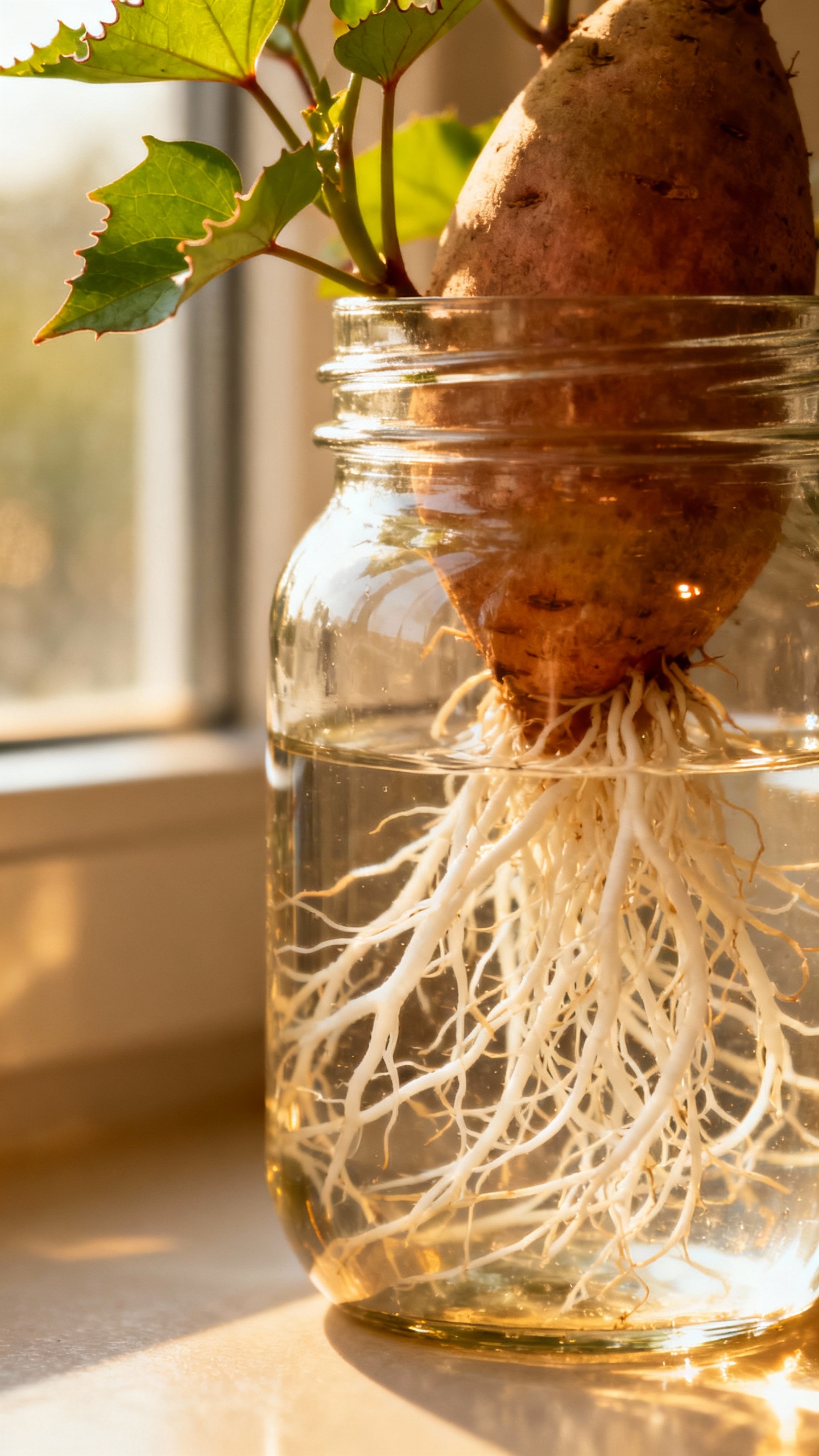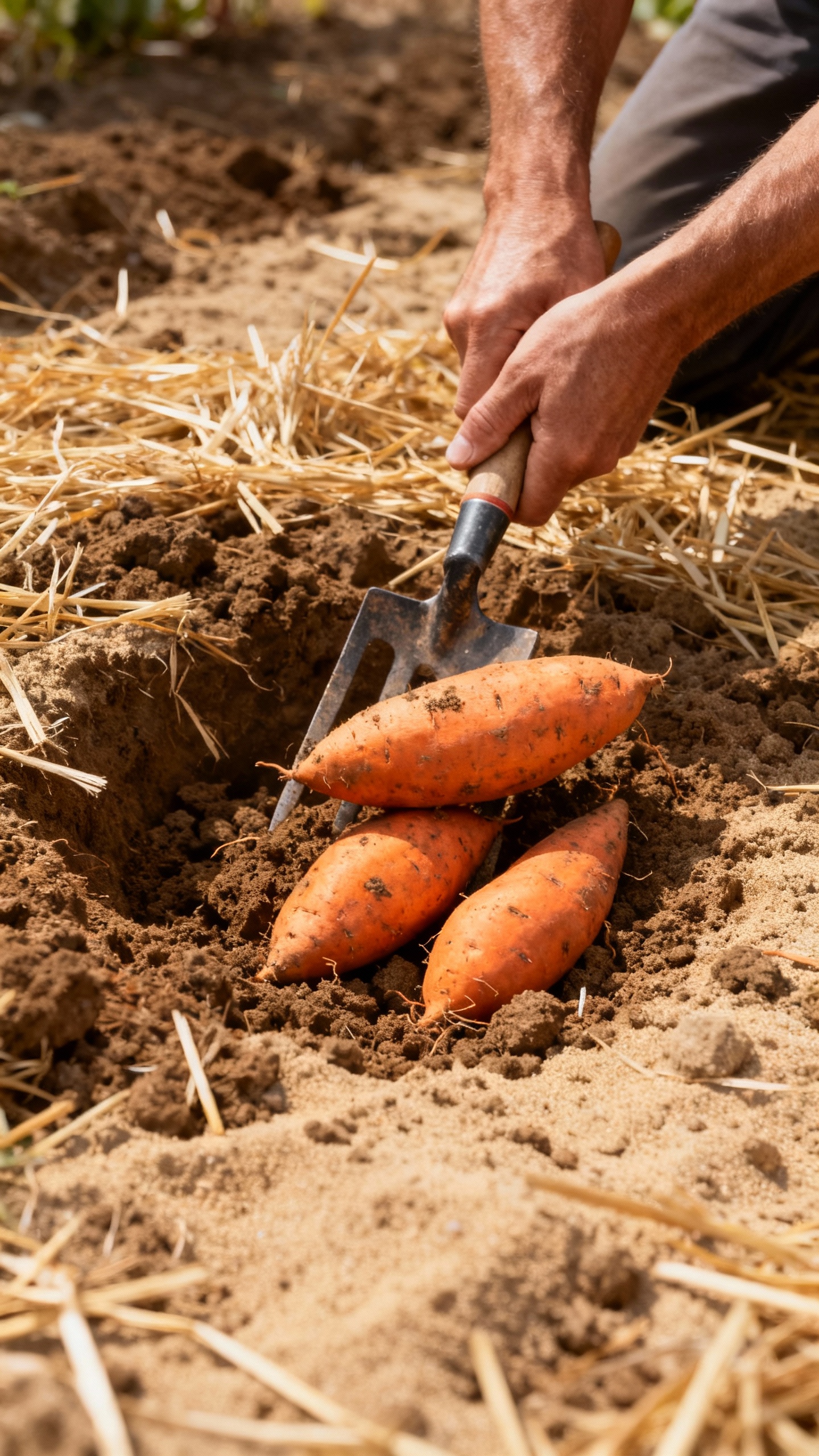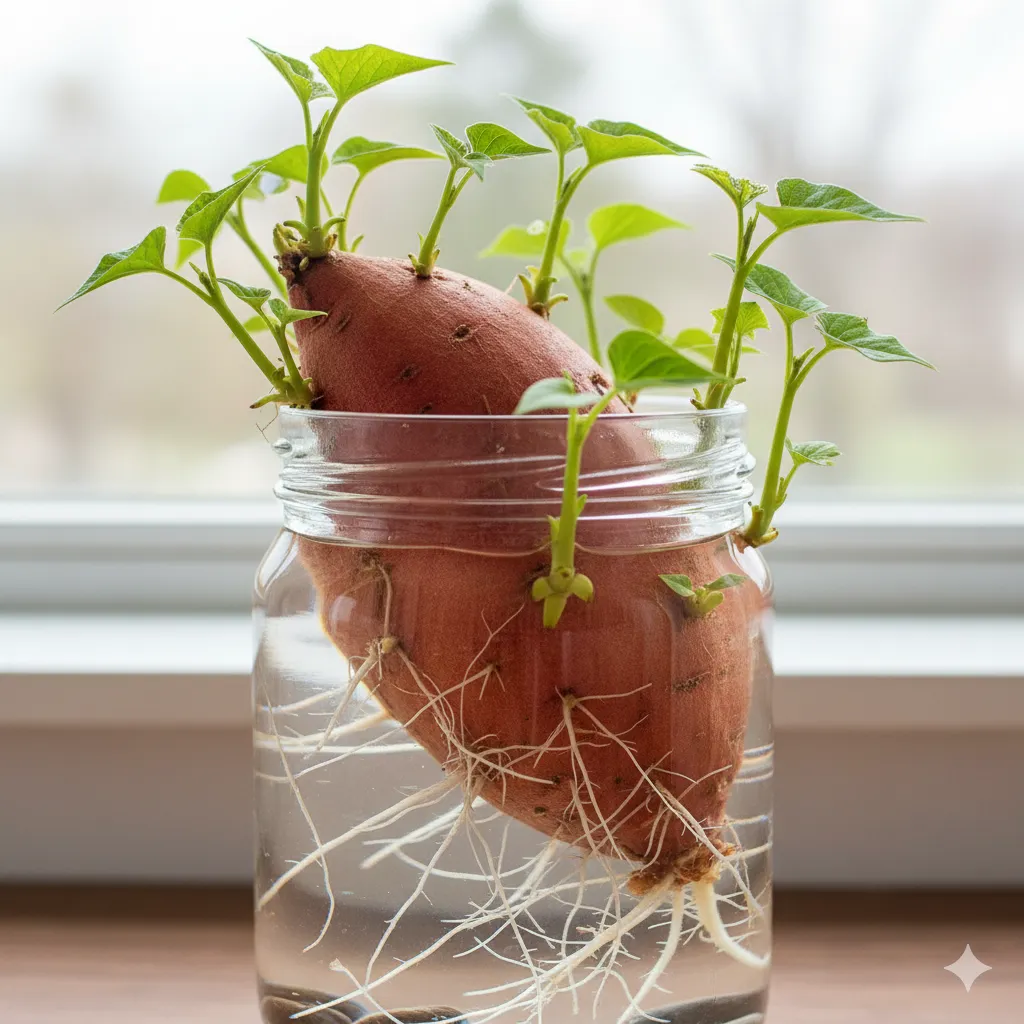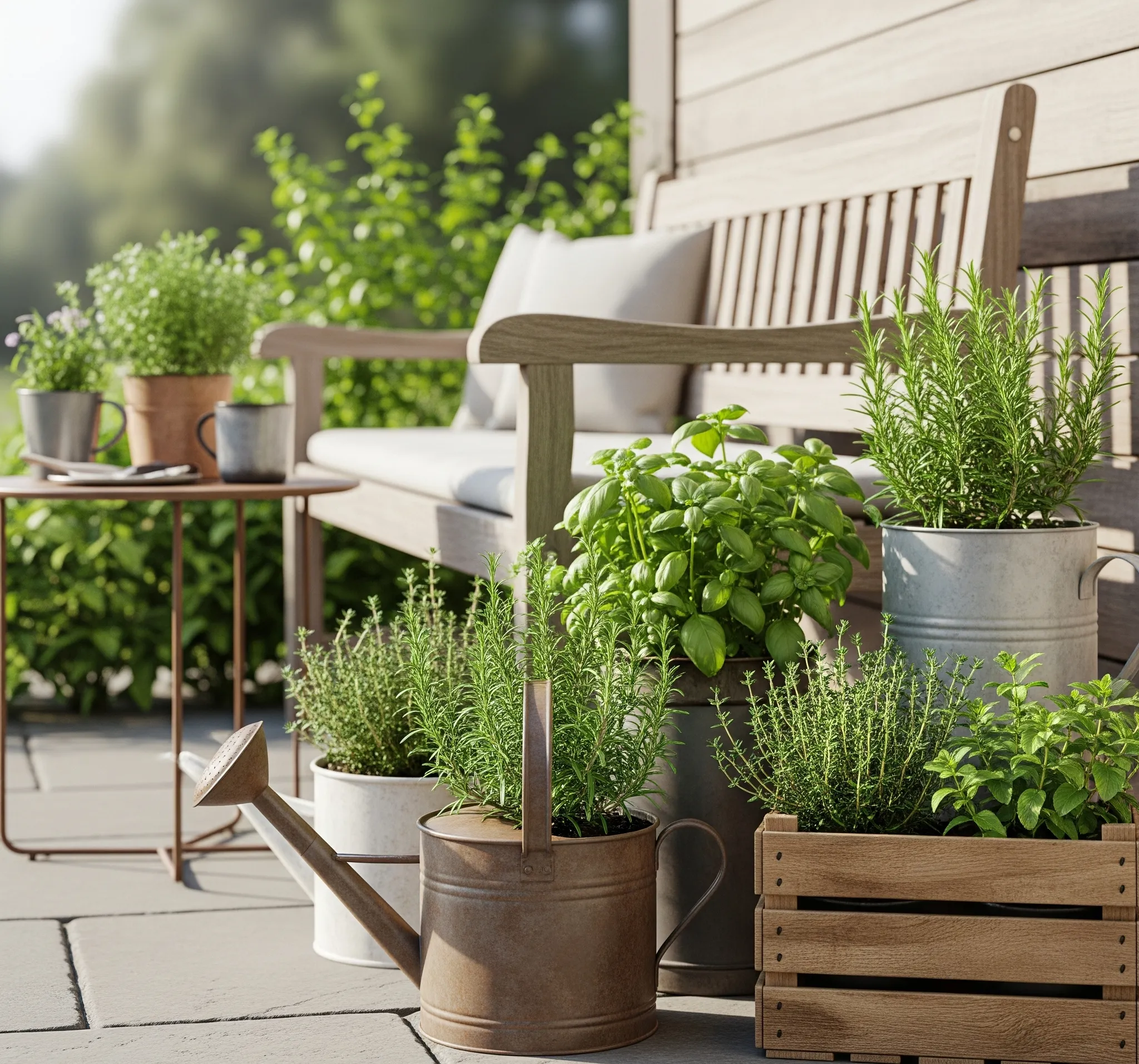Sweet potatoes don’t ask for much, but they give a lot. They climb, sprawl, and churn out candy-sweet tubers that make your garden feel like a treasure hunt. You don’t need a farm or fancy tools—just warmth, patience, and a little know-how.
Ready for a lush, tasty harvest without the drama?
Why Sweet Potatoes Are Your Low-Stress, High-Reward Crop

Sweet potatoes love heat, laugh at poor soil, and produce like champs. They taste better than store-bought and store for months—so you can brag about your harvest well into winter. Plus, their vines look gorgeous, so you get food and garden vibes.
That’s a win-win. Quick vibe check: sweet potatoes are not the same as regular potatoes. They grow from slips (baby sprouts) and want totally different conditions. Treat them like sun-loving divas, and they’ll reward you big time.
Start With Slips (Not Seeds)
You don’t plant sweet potatoes like regular potatoes.
You use slips—rooted sprouts grown from mature sweet potatoes. You can buy slips or make your own for cheap.
How to Make Your Own Slips
- Choose the right potato: Grab an organic sweet potato with no cuts or mold. Conventional ones might be treated to prevent sprouting.
- Sprout it: Place half the potato in water with toothpicks or set it in a shallow tray of water.
Keep it warm (70–80°F) and bright.
- Wait for sprouts: In 2–4 weeks, you’ll see leafy growth. When shoots reach 6–8 inches, twist them off.
- Root the slips: Put slips in water. Roots show up in a week.
Plant when they have a nice root system and no frost threatens.
FYI: You can also sprout directly in a pot of moist soil instead of water. Less fiddly, IMO.

Soil, Sun, and Space: Set the Stage
Sweet potatoes need warmth and loose soil. They hate cold feet and compacted ground.
Think beach vacation, not basement bunker.
Soil Requirements
- Texture: Loose, sandy loam makes fat, smooth tubers. Heavy clay gives you forked, weird shapes. Raised beds help a ton.
- pH: Slightly acidic to neutral (5.8–6.5).
Don’t stress if you’re close.
- Nutrition: Mix in compost before planting. Go easy on nitrogen or you’ll grow a jungle of leaves and tiny roots.
Sun and Temperature
- Sun: 6–8 hours of full sun every day. More sun = sweeter tubers.
- Temperature: Plant when soil temps hit 65°F and nights stay above 55°F.
Cold stunts them fast.
Spacing and Beds
- Rows: Space slips 12–18 inches apart, with 3 feet between rows.
- Raised ridges: Mound soil 8–12 inches high. Warmer, drier, happier roots.
- Containers: Use a 15–20 gallon pot per plant with a loose mix. Great for small spaces.
Planting: Easy, Then Easier
Plant slips deep enough to cover the roots and about half the stem.
This encourages more rooting, which leads to more tubers. Yes, bury them like tiny green submarines.
Step-by-Step Planting
- Pre-water the bed: Plant into moist soil so slips don’t stress.
- Plant deep: Bury 3–4 inches of stem and all roots. Firm gently.
- Mulch: Add straw, shredded leaves, or a light compost layer to keep soil warm and moist.
- Shade for a day: If it’s blazing hot, give them a little temporary shade.
They’ll perk up faster.
Pro tip: If slips look droopy the first week, don’t panic. They sulk, then rally.
Care: Minimal Fuss, Maximum Growth
Sweet potatoes don’t need constant attention. Just keep them hydrated early on and let them sprawl like they’re on vacation.
Watering
- First month: Keep soil evenly moist while plants establish.
- After that: 1 inch of water weekly does the trick, more in drought.
- Stop soaking: Reduce watering the last 2–3 weeks before harvest for sweeter, less watery roots.
Feeding
- Compost at planting: Usually enough for the season.
- Light boost: If growth stalls mid-season, side-dress with compost or a low-nitrogen organic fertilizer.
Vine Management
- Let them ramble: Vines cover soil and suppress weeds.
Free mulch!
- Lift runners occasionally: If vines root at nodes far from the main plant, lift and reposition. This keeps energy focused where you want tubers.
- Small space? Train vines around tomato cages or along edges. They don’t mind.
Pests and Problems
- Sweet potato weevils: Devastating in warm regions.
Use certified slips, rotate beds yearly, and remove plant debris after harvest.
- Wireworms and grubs: Show up in new beds. Avoid planting after grassy lawns. Trap with sliced potato pieces if needed.
- Critters: Voles love tubers.
Use raised beds with hardware cloth on the bottom if they’ve partied in your garden before.
- Fungal issues: Rare if soil drains well. Don’t overwater.
Timing: When and How to Harvest
Most varieties take 90–120 days of warm weather. The vines will keep creeping, but the real magic hides underground.
Don’t wait for flowers. They’re unreliable tattletales.
Harvest Clues
- Calendar: Check your seed packet or variety info and mark your calendar.
- Frost warning: Harvest before frost. Frosted vines send rot vibes down to roots.
Not ideal.
- Test dig: Gently dig one plant with a fork 1–2 weeks before full harvest. Like a preview trailer.
How to Dig Without Tears
- Loosen soil: Start 12–18 inches away from the crown to avoid stabbing tubers. We’re harvesting, not skewering.
- Lift carefully: Sweet potatoes bruise easily.
Shake off dirt, don’t wash yet.
- Keep them shaded: Sunscald happens fast post-harvest. Move them to cure right away.
Curing and Storing for Max Sweetness
Curing turns starches into sugars and heals small nicks. This step takes your sweet potatoes from “pretty good” to “wow, dessert vegetable.”
How to Cure
- Environment: 80–85°F and high humidity (85–90%) for 7–10 days.
- At home: Use a warm closet, laundry room, or a tote with a small bowl of water and a few vent holes.
Keep good airflow.
- No hotbox? Even 70–75°F works—just cure longer (2–3 weeks). They’ll still sweeten.
Storage
- After curing: Store at 55–60°F in a dark, dry place. Not the fridge—cold makes them hard and weird-tasting.
- Shelf life: 3–6 months, sometimes longer.
Check occasionally and remove any sketchy ones.
Best Varieties for Home Gardeners
You’ve got options. Choose based on climate and flavor goals. Yes, they all taste sweet, but some hit different.
- Beauregard: Early, dependable, orange flesh.
Great for beginners.
- Covington: Smooth texture, stores well, classic flavor.
- Murasaki: White flesh, purple skin, nutty and less wet. Killer for fries.
- Georgia Jet: Extra-early in cool climates.
- Vardaman: Compact habit, good for small spaces and containers.
IMO: Grow one early and one storage champ for a steady sweet potato pipeline.
FAQ
Can I plant a whole sweet potato instead of slips?
You can, but slips work better. Whole tubers can rot or produce too many shoots clustered in one spot.
Slips give you stronger, spaced-out plants that yield more evenly.
Do sweet potatoes need a lot of fertilizer?
Nope. Overfeeding with nitrogen gives you lush vines and sad tubers. Start with compost, then add a light side-dress mid-season if plants look pale.
Think “gentle meal,” not “all-you-can-eat buffet.”
How many plants do I need per person?
Plan 3–5 plants per person if you want a steady stash. Expect 3–6 tubers per plant depending on variety and conditions. Serious sweet potato lovers might double that.
No judgment.
Why are my sweet potatoes long and skinny (or weirdly forked)?
Compacted or rocky soil, inconsistent watering, or fresh, hot manure can cause funky shapes. Loosen the soil, keep moisture steady, and avoid too much nitrogen. They’re still edible, just… “rustic.”
Can I grow them in a cool climate?
Yes, with a head start.
Use black plastic or landscape fabric to warm the soil, plant early-maturing varieties, and consider row covers for chilly nights. Containers on a sunny patio also warm up faster.
Are the leaves edible?
Absolutely. Treat them like spinach—sauteed, stir-fried, or tossed in soups.
Harvest younger leaves for tender texture. Bonus crop for the win.
Wrap-Up: Easy In, Delicious Out
Sweet potatoes want warmth, sunshine, and loose soil. Give them that, and they’ll gift you a basket of orange (or purple!) gold with minimal drama.
Start a few slips, let the vines sprawl, cure your harvest, and you’ve got comfort food for months. Grow them once, and you’ll wonder why you waited so long—FYI, future you will thank you.


